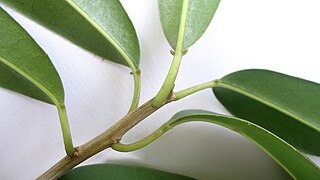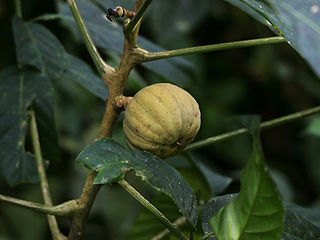
Sapium is a genus of flowering plants in the family Euphorbiaceae. It is widespread across most of Latin America and the West Indies. Many Old World species were formerly included in the genus, but recent authors have redistributed all the Old World species into other genera.
Pachystroma is a monotypic plant genus in the family Euphorbiaceae first described as a genus in 1865. It is the only genus of its tribe (Pachystromateae). The only known species is Pachystroma longifolium, native to Brazil, Bolivia and Peru.
Mareya is a plant genus of the family Euphorbiaceae, first described as a genus in 1860. It is native to tropical western and central Africa.
Mareyopsis is a plant genus of the family Euphorbiaceae first described as a genus in 1919. It is native to western and central Africa.
- Mareyopsis longifolia(Pax) Pax & K.Hoffm. - Nigeria, Cameroon, Gabon, Equatorial Guinea, Congo-Brazzaville, Zaire
- Mareyopsis oligogynaBreteler - Gabon
Crotonogynopsis is a plant genus of the family Euphorbiaceae first described as a genus in 1899. It is native to tropical Africa.
- Crotonogynopsis akeassiiJ.Léonard - Ivory Coast, Ghana
- Crotonogynopsis usambaricaPax - Cameroon, Zaïre, Uganda, Tanzania, Mozambique
Cyttaranthus is a plant genus of the family Euphorbiaceae first described as a genus in 1955. It contains only one known species, Cyttaranthus congolensis, native to tropical Africa.
Aparisthmium is a plant genus of the family Euphorbiaceae first described as a genus in 1840. It contains only one known species, Aparisthmium cordatum, native to South America and Costa Rica.
Necepsia is a plant genus of the family Euphorbiaceae first described as a genus in 1910. It is native to Madagascar and to tropical Africa.
- Necepsia afzeliiPrain - Liberia, Sierra Leone, Ivory Coast, Ghana, Cameroon, Congo, Cabinda, Gabon
- Necepsia castaneifolia(Baill.) Bouchat & J.Léonard - Tanzania, Zimbabwe, Madagascar
- Necepsia zairensisBouchat & J.Léonard - Congo, Zaire
Cheilosa is a monotypic plant genus of the family Euphorbiaceae first described as a genus in 1826. Only one species is recognized: Cheilosa montana, native to Southeast Asia.
Astrococcus is a genus of plant of the family Euphorbiaceae first described as a genus in 1854. It contains only one known species, Astrococcus cornutus, native to neighboring states of identical names, Amazonas State in southern Venezuela and Amazonas State in northwestern Brazil.
Haematostemon is a genus of plant of the family Euphorbiaceae first described as a genus in 1919. It is native to northeastern South America.
- Haematostemon coriaceus(Baill.) Pax & K.Hoffm. - Amazonas State in S Venezuela
- Haematostemon guianensisSandwith - Potaro-Siparuni region of Guyana
Argomuellera is a genus of plant of the family Euphorbiaceae first described as a genus in 1894. It is native to sub-Saharan Africa, Madagascar, and the Comoros Islands.
Benoistia is a genus of shrubs or trees of the spurge family (Euphorbiaceae) and the monotypic subtribe Benoistiinae. It was first described as a genus in 1939. The entire genus is endemic to Madagascar.
- Benoistia orientalisRadcl.-Sm. - N + E Madagascar
- Benoistia perrieriH.Perrier & Leandri - Madagascar
- Benoistia sambiranensisH.Perrier & Leandri - N Madagascar
Cavacoa is a plant genus of the family Euphorbiaceae first described as a genus in 1955. All the species are native to sub-Saharan Africa.
- Cavacoa aurea(Cavaco) J.Léonard - Kenya, Malawi, Mozambique, KwaZulu-Natal
- Cavacoa baldwinii(Keay & Cavaco) J.Léonard - Sierra Leone, Liberia
- Cavacoa quintasii(Pax & K.Hoffm.) J.Léonard - Annobón, São Tomé, Zaïre
Grossera is a plant genus of the family Euphorbiaceae first described as a genus in 1903. It is native to Madagascar and to mainland tropical Africa.
- Grossera angustifoliaBarbera&Riina - Equatorial Guinea
- Grossera elongataHutch. - Príncipe
- Grossera glomeratospicataJ.Léonard - East Congo
- Grossera macranthaPax - East Congo, West Congo, Cameroon, Central African Rep.
- Grossera majorPax - Cameroon
- Grossera multinervisJ.Léonard - East Congo, São Tomé
- Grossera paniculataPax - West Congo, Cameroon, Gabon
- Grossera perrieriLeandri - Madagascar
- Grossera vigneiHoyle - Ivory Coast, Ghana, West Congo

Hura is a genus of trees in the family Euphorbiaceae described by Carl Linnaeus in 1753. It is native to South America, Mesoamerica, and the West Indies.
Anthostema is a flowering plant genus in the Family Euphorbiaceae first described as a genus in 1824. It is native to Africa and Madagascar.
- Anthostema aubryanumBaill. - W + C Africa from Ivory Coast to Cabinda
- Anthostema madagascarienseBaill. - Madagascar
- Anthostema senegalenseA.Juss. - W Africa from Senegal to Benin
Oligoceras is a plant genus of the family Euphorbiaceae, first described as a genus in 1924. It contains only one known species, Oligoceras eberhardtii, endemic to Vietnam.

Sclerocroton is a plant genus of the family Euphorbiaceae first described as a genus in 1845. There a total of 6 known species in this genus; 5 species in continental Africa and a single species in Madagascar.
- Sclerocroton carterianus(J.Léonard) Kruijt & Roebers - Liberia, Ivory Coast, Sierra Leone
- Sclerocroton cornutus(Pax) Kruijt & Roebers - C + SC Africa from Cameroon to Zimbabwe plus Ivory Coast
- Sclerocroton integerrimusHochst. - C + S Africa from Zaire to KawZulu-Natal, plus Guinea
- Sclerocroton melanostictus(Baill.) Kruijt & Roebers - Madagascar
- Sclerocroton oblongifolius(Müll.Arg.) Kruijt & Roebers - Zaire, Angola, Zambia, Zimbabwe
- Sclerocroton schmitzii(J.Léonard) Kruijt & Roebers - Zaire, Rwanda, Burundi, Zambia, Zimbabwe
Protomegabaria is a genus of flowering plant belonging to the family Phyllanthaceae first described as a genus in 1911. It is native to western and central Africa.
- Protomegabaria macrophylla(Pax) Hutch. - Nigeria, Cameroon, Republic of the Congo, Gabon, Gulf of Guinea Islands
- Protomegabaria meiocarpaJ.Léonard - Gabon, Democratic Republic of the Congo
- Protomegabaria stapfiana(Beille) Hutch. - West Africa


